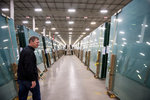

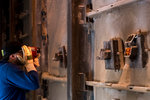
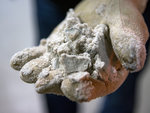
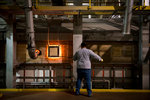
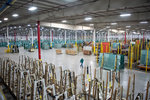
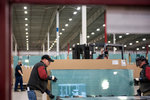
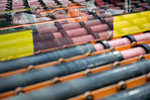
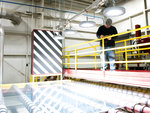
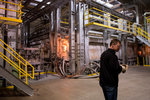
It has been 10 years since Cardinal Glass Winlock opened its doors.
While the glass market, consumer demand and many of the ways their customers do business have changed over that time, what Cardinal Winlock does has largely remained unchanged, said Plant Manager Steve Smith.
Smith has been a Cardinal employee for 25 years. He came from a float glass plant in Oklahoma to help oversee the Winlock plant’s construction. The factory officially opened for business in September 2006. Smith explained that the Winlock location’s creation was part of a greater expansion project for its parent company of Cardinal Glass Industries, which is comprised of 37 locations employing about 6,000 workers nationwide. Plants were also built in Chehalis and Hood River, Oregon, in about the same timeframe as Winlock. Smith said he was proud to be part of the expansion and has enjoyed his new home in the Northwest.
“It was a good move. It’s a beautiful area,” Smith said
The Cardinal FG Winlock produces what is called float glass. Other Cardinal location products include insulated glass, coated glass, laminated glass and custom tempered glass. At Cardinal Winlock, raw materials, including sand, limestone, soda ash and recycled glass, are melted down in the 1,700-ton furnace. As it travels down the line, the melted glass is then floated in a bath of tin, hence the name float glass. Tin is used as a conduit for this long ribbon of melted glass as it is slowly pulled into a sheet shape. It is an inexpensive, non-toxic and neutral material with a melting point of about 450 degrees whereas the molten glass starts at close to 3,000 degrees.
Cardinal’s furnace can produce 27 tons of material per hour, or about 648 tons per day. In 10 years of operation, the plant has produced more than 2.4 million tons of glass. It also runs around the clock, year-round. The furnace has run without stopping, even during holidays and power outages, since 2006. Smith explained that while the furnace can be turned to “hot hold” briefly if needed, the cost of shutting down the high-heat furnace and then re-heating it to the correct temperatures would take more time, money and manpower than simply running non-stop.
“From an operational standpoint, we’d rather crush glass and melt it and reshape it than turn the furnace off,” Smith said. “Our quality is best and our productivity is best when we’re running consistently.”
Along the long conveyor belt, the glass is constantly heated and shaped. Smith said that many cameras and vantage points allow employees to watch that the glass is flowing smoothly, looks correct and that temperatures are precisely controlled. If the molten glass is cooled too slowly or quickly along the line, it can result in any number of flaws, including brittle glass, un-melted particulates in the glass, cracks or warps and even a fusing of metal and glass.
“It almost comes from a science and an art,” Smith said. “They’ll have the technical knowledge and also a feel for what it’s supposed to look like.”
Cooled properly, the molten glass eventually reaches a viscosity that allows it to hold a solid shape. The finished glass sheets are machine-cut to order typically in sizes ranging from 8-inch by 20-inch to their biggest sheets which are 120-inch by 204-inch. Any unused or unusable pieces of glass are fed by conveyor belt back to the beginning of the process to become part of the next batch of glass.
About 80 percent of the product produced at Cardinal FG Winlock goes on to another Cardinal plant such as Chehalis, Tumwater or Hood River for additional work. That can include the addition of energy efficient coatings. Most of the glass will be used for residential windows, primarily on the West Coast, although some of the product is also exported to Japan.
The other 20 percent or so of Cardinal FG Winlock’s product is shipped directly to customers. The plant’s warehouse holds a minimum of about 12,000 tons of inventory at any given time, which might seem like a lot of glass but on a busy day the facility can ship out 600-1,000 tons of glass.
“So, when you get busy you can lose inventory pretty quick,” Smith said.
Cardinal FG Winlock employs about 210 people. It takes about 40 workers to run the operation at any one time, not including support staff. Smith is proud to note that the plant is below industry standards for accidents, although he said it may be because of their constant stressing with employees that it is very dangerous work.
“It’s a little different pace and a different life,” Smith said of work at the facility. “Sometimes it’s late night phone calls and missing holidays and birthdays because you’re needed here. It’s not for everyone.”
When Cardinal first opened the Winlock plant, much of the workforce was comprised of current Cardinal employees who were relocated from other plants. Smith said today, the workforce talent is primarily local. Although entry-level jobs require only a high school diploma, Smith noted that the eight to 10 promotions they have made at the plant have all been from within their current workforce, so upward mobility is a possibility.
“Our requirement is if you can work in a team environment, you can work and you can learn,” Smith said. “We like to reward people who go the extra mile and show initiative and who are loyal.”
Not long after the Winlock plant’s opening, the recession hit the country and the residential glass market went down along with the reduction in the construction market. The answer for Cardinal was to increase its stake in creating solar panels. For Winlock, the switch was a boon, since it required the same glass the plant was already producing. For the Chehalis plant, Smith noted, the increase in solar technology meant an expansion of the plant to accommodate new machinery that could put solar coatings on the glass. The demand for solar panels has now waned and much of the solar panel production is now handled in China. The decrease has led to reductions in workforce and renovations for the Chehalis plant, but Winlock was able to simply continue doing what they had done all along.
“We’ve been very fortunate during the recession,” Smith said.
Much like the solar panels, Smith believes the future of the glass industry will also be in activities that take place downstream from the Winlock plant. More energy efficient coatings for glass, including those with high-tech capabilities, will likely be the next thing consumers will demand. One of the products Smith has seen demonstrated is glass that has coatings that allow the glass to go from clear to shaded with a touch of a button as well as glass or mirrored surfaces that can display computer or television screens within the surface. These changes are not likely to alter the work that the Winlock float glass plant does today, other than a few adjustments to make the glass compatible with the newer coatings.
“When they come up with better coatings we have to make the glass better quality,” Smith said.
The more looming change coming for Winlock will be the end of the life cycle for the plant’s furnace. The bricks that make up almost the entirety of the outside of the furnace (think high school ceramics kiln on a larger scale) eventually begin to wear thin and have to be removed and replaced. With a furnace that runs nonstop year-round, this overhaul requires a complete shut-down of the furnace for a period of about 90 days. Smith said he would estimate that the furnace is about five years away from being replaced, and planning for such a shutdown begins about two years before the actual event. He explained that frequent and precise measurements throughout the furnace are a gauge for how soon this would have to take place, and the trick is to choose a time that is not too soon or too far out.
“It’s like a car, you want to replace it before it runs out of gas and leaves you stranded,” Smith said.